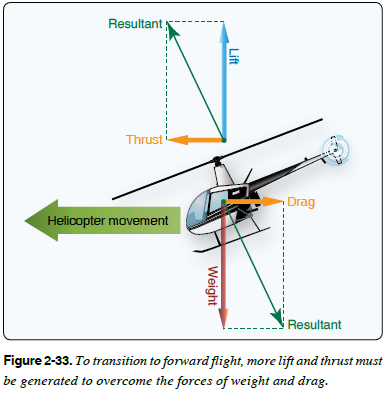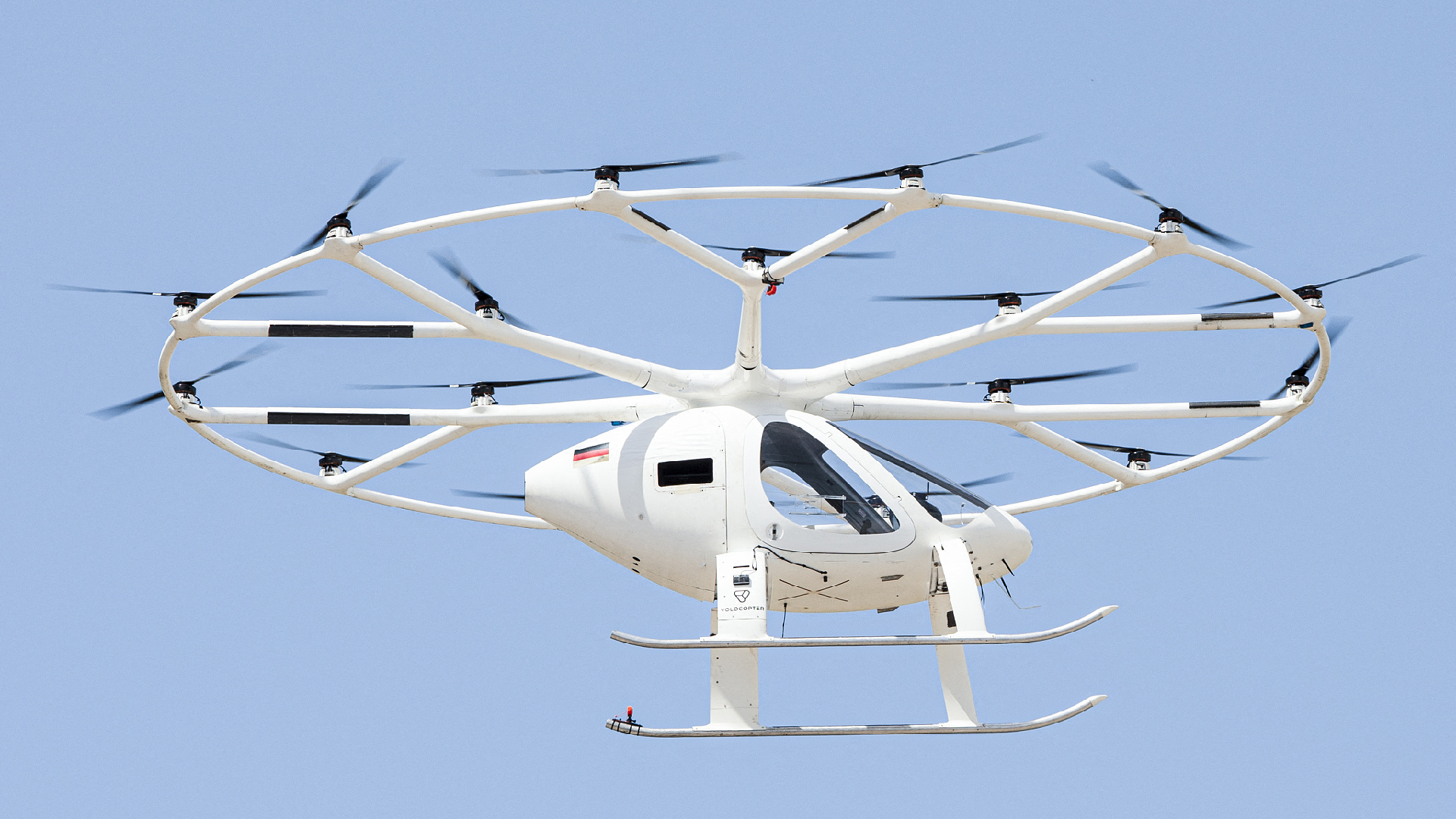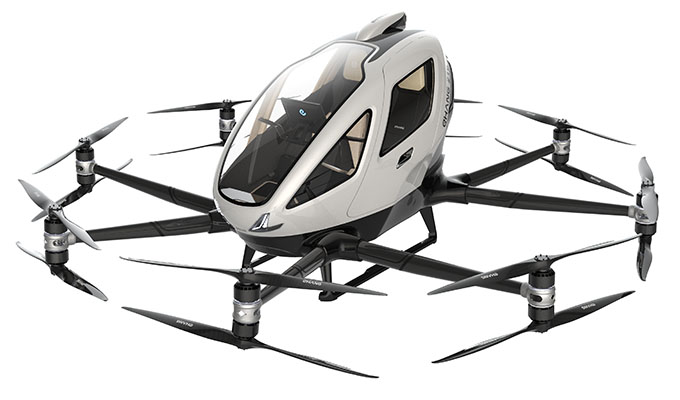Leeham News and Analysis
There's more to real news than a news release.
Bjorn’s Corner: Sustainable Air Transport. Part 27. Multicopters.
July 8, 2022, ©. Leeham News: We will start the analysis of the market’s most prominent VTOL variants by looking at the simplest version, multicopters.
When we analyze the multicopters, we can go through some fundamentals of how VTOL operates and the technology used.
Multicopters and their fundamentals
The VoloCity, Figure 1, and EHang 216, Figure 2, are multicopters that have been flying for several years. Their flight technology is an outgrow of the drone industry’s findings on how to make a simple yet functional vertically starting vehicle using several electric motors that can drive RPM-controlled rotors.
By spinning the motors in different directions and differentiating their RPM, you can control the altitude, the pitch angle, the roll, and the yaw. By tilting the multicopter forward, it will fly forwards.
As these vehicles are battery-powered and batteries are heavy, their capacity is strictly limited. Therefore, the lift systems energy consumption is critical for multicopters.
The amount of power needed to lift the VTOL vertically depends on the disc loading, which is the VTOL’s mass divided by its total rotor area. Low disc loading results in less power consumption, whereas higher disc loading increases the power requirements. The VoloCity has a disc loading of 217kg/m2 or 4.1lb/ft2 when fully loaded with two persons whereas the EHang disc loading loaded with two persons is 178kg/m2 or 3.4lb/ft2.
Disc loading is not something special for VTOLs or helicopters (where the term is used). As explained in Part 16, it’s just another name for what we know as specific thrust from turbofans or propeller loading from a propeller aircraft.
All propulsion systems are air pumps, and they work more efficiently if they accelerate a large mass of air to a small overspeed than vice versa. If your rotor capture area is large, then you only need to give the air a modest overspeed through the rotor to generate the thrust to hover.
Simple but energy-consuming
The drone-like architecture of the multicopters is simple, but as the rotors are responsible for keeping the unit at a constant altitude with hover power, they represent an energy-intensive version of VTOLs. Their range is, therefore, short, typically less than 20 miles.
For forward flight, the rotors must deliver more thrust as some thrust must compensate for the drag of the forward motion, Figure 3. The wedgewise forward flight limits the achievable speed with acceptable rotor thrust. The top speed of the VoloCity is 60kts.

Figure 3. The combination of lift and thrust to fly forward for a helicopter and multicopter. Source: FAA Helicopter Handbook.
Safety through redundancy
To make the mulitcopters safe, substantial redundancy is needed. The VoloCity has 18 rotors with motors, where the motors are fed from nine inverters and batteries in a scheme that gives the unit a high degree of redundancy from rotor, motor, electronics, or battery failure.
The EHang 216 has 16 rotors and motors with a multitude of electrical drive paths for the same reason.
The method of forward flight (Figure 3) is a variation of vertical flight. As the rotors’ thrust is only a bit higher than for hovering, the airflow variation through the rotors stays modest.
Therefore, fixed rotor blades can be used. It makes the aerodynamics of the rotors simple; no pitch change mechanisms are needed.
An area that must be considered is the risk of flutter in the rotors. During forward flight, the load on the rotors changes, and rotors can fly into the wake of other rotors. Flutter problems with rotors constitute a significant problem, and this is why the regulators require a lot of evidence the subject has been thoroughly analyzed before test flights.
During test flights, the OEM has to demonstrate that the vehicle can safely fly with different weights and centers of gravity through all possible maneuvers and speeds to ensure there will be no rotor flutter problems in operations.




It seems that a big disadvantage of rotors/propellers is that every aero surface on it operates at a different air velocity linearly related to its effective radius. i would suppose that many small rotors are more efficient than a single large one covering the same swept area.
I guess you see this evidenced in different twists at different radius’s on the propeller.
But i suppose the only solution would be messy, some sort of shutter-like arrangement
EHang does not look customer friendly for boarding, even with the rotors stopped!
Is there any reason that Multicopters have to be battery powered ?
Clearly it is an advantage to have the rotors powered by electricity, but couldn’t the electricity be generated on board using conventional fuels ?
Would it be an advantage if some or all of the rotors could tilt rather than tilting the whole craft ?
Doesn’t it help to have multiple rotors with lower tip speeds than a conventional helicopter ?
Yep, you could have an APU like the 787 with a couple of 225 KW generators.
But then the weight of that stuff and the fuel and …… What works in a car does not work in an aircraft due to all the weight you add up.
Ergo, Hybrid cars use a battery to supplement the engine. In the case of the Ford F-150 Hybrid Pickup, you get more torque and economy than a diesel engine (a first) so Ford is dropping the diesel in that line.
You can also do fuel cells but again, weight of the unit and the fuel and you wind up not working.
When I was a lad of 7 or so, my folks were into U Control Airplanes. They were fast and speedy and tricky so they bought a C-172 Plastic that the motor was battery powered as a trainer.
The only way you could get it to fly was to Step back and sling it and its was dicey to keep it flying (we did not have a huge field to work with so once you hit the tree line the plane hit them next)
No question it was the plastic weight and the too small a battery, if it was balsa like the ones they built it would have been ok as we have now in other ways CRF, Li Ion
If weight is the driver like it is in aircraft, then the only thing that works is liquid fuel and direct power be it a ICE, Turbo Prop or Jet.
You need max density of fuel and that is gasoline and kerosene.
The trend is swivling engine/rotors and wings like Lilium Jet to improve cruise performance and range. We will see some of them at the Paris Olympics 2024. Most likely will the military order and arm them as consumable unmanned bombers close to the battle. Packing as many as possible folded into a 40′ container will be a selling point.
-I don’t think ex CEO and founder Daniel Wiegand will be entirely happy with military applications. As an admirer or Otto Lilienthal (who was into profit sharing with his employees) he is a bit of a one world peacenik. Having said that he is no doubt horrified with what is happening in Ukraine.
-LiliumJet should be easy to apply radar stealth to (Jaumann absorbers, ferrite coats etc). It will have a very low infrared signature which is interesting. I see smaller versions as unmanned high speed delivery drone but no doubt it could be a weapons carrier. Perhaps with folding wings it could be extracted from a C130 type aircraft and fly back and be hooked up and winched on board again.
We will see who the buyers will be, they fit better in urban environments where you have the power grid to feed them and sensitivity to noise. The military need to charge them from diesel/JET A powered units, stealth and low noise is a plus for the military, but unmanned autonomous flight and full of sensors and weapons it will be hard to resist for the military bean counters. One soldier hurt and his buddy order one with his MIL-Smartphone and quietly one lands next to the phone and he load his buddy that gets a low terrain-following flight to the base medic. If the UAM take a shot it will send a Hellfire missile back to the shooter. They might be able to fly high enough to cool beer in its underslung cargo like the Flying tigers did.
I would call it speed controlled motors or rotors.
-“Quadcopter” and similar type multicopper with unarticulated rotors would seem to be reasonably efficient at hovering but inefficient at forward travel. The efficiency at the hover would however be related to the disk loading and a helicopter would tend to have lowest wheras a ducted fan the worst. Many such multicopter aircraft that are being designed for eVTOL “air taxi’ like service feature stub wings and a separate set of propellers or electric fans purely for forward flight such as Airbus’s Citybus and Volocopter VoloConnect.
-The attraction is mainly low noise, ease and simplicity of maintenance, safety through redundancy and the enormous ease of flying these aircraft.
-I suspect we may yet see all electric helicopters which will have multiple redundant electric tail rotors and a very simple gearbox that is merely a single stage planetary reduction gear drive by a low RPM electric motor. These may have some of the advantages of multicopters such as ease of control and flying through an FBW system, low noise etc.
-There are some situations where hover is all that really is important to the mission. For instance Volocopter have a drone version of the Volocopter called Volodrone that can carry ou agricultural spraying, probably fire fighting and some kinds of delivery.
What happens to a multicopter in the event of a total power failure?
I have met many aviation professionals who refuse to board a helicopter, would a multicopter actually be safer owing to greater redundancy? What would be the weight cost of making each rotor completely independent?
-The mechanical systems of multicopper are not highly stressed like that of a helicopter and in that regard might be much safer. So long as more than a quadcopter also highly redundant.
-Volocopter will have 9 battery packs in triple triplicated architecture and LiliumJet 12 battery Packs. Joby would be similar. So total electrical failure is extremely unlikely. But for the sake of argument lets assume a malevolent or inebriated pilot forces the aircraft into total battery depletion. I would see 5 options:
1 Aircraft simply tumbles out of the sky. (unlikely)
2 Declining battery voltage causes the aircraft to descend in a semi controlled way as the rotors can not maintain power to maintain altitude but the batteries maintain some controllability keeping the aircraft level though descending.
3 If the batteries reach a predetermined SOC “State of Charge” of approximately 7.5% the aircraft FBW system automatically enters an irrevocable descent (say at 5 meters a second equal to jumping from 1.25 meter height) at limited forward speed which reduces to 2.5 meters a second 10 meters above ground.
4 An ballistics parachute is deployed as used on several light aircraft and some unmanned drones.
5 Aircraft enters into an automatic irreovacable fly back recovery mode to nearest landing point.
6 I have a theory: If there is no battery power at all (apart from control power) there might still be a way. As the multicopter falls the rotors will start turning in the reverse and ‘wind milling’ effectively turning the rotors into generators whose speed can be controlled by the variable speed drives. This means the multicopter can be made to fall in an upright direction and the speed of fall can be reduced perhaps to a survivable level perhaps in combination with a drogue parachute.
-I would think the many ‘single points of failure’ on a helicopter (hub, gearbox, tail rotor, pitch mechanism) would make them worse despite the autorotation capability they have.
The most disruptive part for me on these designs is how investors are ready to pony up the money while it is so clear capabilities will remain so limited and safety / noise requirements won’t be softened.
And it’s a disruptive observation that many smart engineers are contributing, deep down understanding this will end nowhere. But if it pays well now & you learn a lot, it’s not bad experience for a few years.
Hopefully overtime, there’s lots of technology spin-off towards more useful, feasible products.